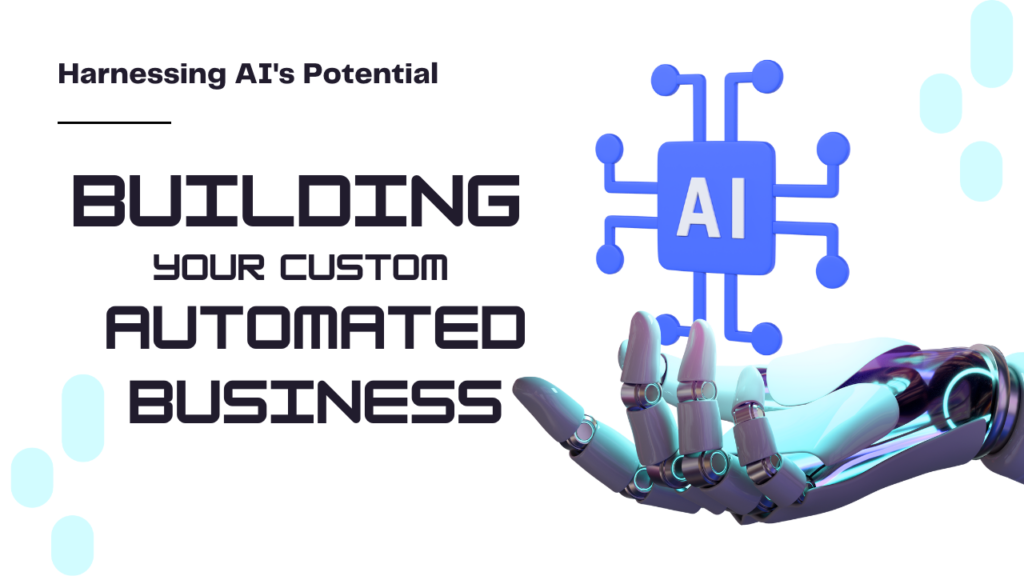
Table of Contents
- 1 Introduction
- 2 Understanding Your Business Needs
- 3 Data Collection and Preparation
- 4 Machine Learning and AI Model Development
- 5 Integration of AI Automation
- 6 Testing and Deployment
- 7 Monitoring and Continuous Improvement
- 8 Staff Training and Change Management
- 9 Legal and Ethical Considerations
- 10 Continuous Evaluation and Adaptation
- 11 And…
- 12 FAQ
Introduction
Welcome, ambitious business leaders, to the thrilling frontier of AI-driven automated enterprises. Imagine an enterprise where robots handle the mundane, data crunching is effortless, and decisions come quicker than a lightning bolt. In this insightful piece, we’ll guide you on a transformative journey to reinvent your business operations using the sheer prowess of artificial intelligence and automation. Get ready, as we’re about to reshape your business landscape!
Understanding Your Business Needs
Kickstarting this AI-centric voyage, it’s vital to discern which facets of your business are prime candidates for automation. Do mundane tasks leave your team feeling overwhelmed? Pinpoint these tiresome processes and earmark them for automation. Next, delineate your aspirations. Whether it’s cost-cutting, boosting productivity, or freeing up time for leisurely breaks, set concrete targets for your AI-based automation endeavor. Also, remember to evaluate your available resources and budget – because quality AI systems come with a price tag!
Data Collection and Preparation
Data – the lifeblood of AI. Start collecting pertinent data from every conceivable part of your business. Search every digital crevice and corner, and ensure no data-rich area remains untouched! Once you’ve accumulated this wealth of data, it’s time to cleanse it of inaccuracies, duplications, and missing values. We aim for immaculate, high-quality data because remember, the quality of output is directly proportional to the quality of input.
Machine Learning and AI Model Development
Now, we dive into the fascinating process of constructing your AI models. Think of it as the quintessential scientist’s experiment, minus the mad chuckling. Select your machine learning algorithms based on the problem at hand, be it classification, regression, or clustering. Use your cleaned data to train and fine-tune these models, and ensure their performance is up to par. Continue refining until you have an AI model akin to a digital virtuoso.
Integration of AI Automation
It’s time to let your AI models take center stage! Identify the operations most deserving of automation. Whether it’s customer service, data analysis, or something else entirely, the sky is the limit! Choose or develop the AI-powered tools best suited for your needs. Once you’ve compiled your lineup of automation champs, incorporate them into your existing systems and workflows, ensuring a seamless fusion.
Testing and Deployment
Before setting your automated system free, rigorous testing is a must. View it as a dry run for the imminent automation showcase. Debug and iron out any issues with the diligence of a dedicated troubleshooter. After successfully passing these tests, initiate a controlled deployment to validate its effectiveness and gather valuable feedback.
Monitoring and Continuous Improvement
Once your AI-driven marvel is operational, keep a keen eye on its performance. Define relevant metrics and KPIs to quantify success. Diligently monitor the system’s performance and use these insights to fine-tune and evolve the system. Just as Rome wasn’t built in a day, AI systems also require patient nurturing and improvement.
Staff Training and Change Management
Now that your business is AI-enhanced, it’s essential to bring your team up to speed. Educate your staff about the advantages of AI automation, getting them excited about the new system. Train them on how to effectively work alongside these automated systems, equipping them with the necessary skills and knowledge. Acknowledge their apprehensions and offer reassurance—change can be daunting, but it’s less intimidating with proper support and guidance.
Legal and Ethical Considerations
As your business navigates the AI landscape, compliance with laws and ethical guidelines is crucial. Ensure adherence to data privacy and security regulations to avoid potential legal pitfalls. Maintain transparency and minimize biases in your AI system. Also, implement protective measures to mitigate potential risks and liabilities—because prudence is the best policy when dealing with AI.
Continuous Evaluation and Adaptation
Well done trailblazer of AI! However, remember that this journey is ongoing. Continually assess the impact and ROI of your AI automation. If the system isn’t performing as expected, be ready to adapt and tweak it based on evolving business requirements. Cultivate a culture of ongoing improvement and innovation, just like adding more layers to an already rich cake.
And…
And there we have it, daring business pioneers—a comprehensive guide to establishing your personalized AI-based automated business. By comprehending your needs, leveraging data, developing AI models, implementing automation, and fostering continuous enhancement, you are all set to surf the wave of the future. So, strap on your virtual reality gear and embark on this transformative AI expedition. Remember, with AI at your disposal, the opportunities are as vast as the galaxy. Here’s to automation success!
FAQ
What is an AI-based automated business?
An AI-based automated business leverages the power of Artificial Intelligence (AI) and automation to streamline processes, increase productivity, reduce costs, and enhance decision-making capabilities.
Why should I automate my business with AI?
AI automation can help your business become more efficient, reduce human errors, free up time for strategic thinking, and provide valuable insights from your data. It can also lead to better customer experiences, improved product quality, and increased profits.
What aspects of my business can be automated with AI?
AI can automate a variety of business processes, including data analysis, customer service, inventory management, sales forecasting, and more. The decision to automate depends on your specific business needs and goals.
How do I start the process of AI-based automation?
Start by understanding your business needs, determining which tasks could benefit from automation, and setting clear objectives. Then, gather and prepare your data, develop your AI models, and integrate them into your business processes. Remember to conduct testing and continuous evaluation for improvement.
Is AI automation expensive?
The cost of AI automation can vary widely depending on the complexity of tasks, the specific AI tools used, and the level of customization required. However, the long-term benefits often outweigh the initial investment.
What are the legal and ethical considerations of AI automation?
AI automation must comply with all applicable laws and regulations, especially those related to data privacy and security. Ethical considerations include avoiding biases in AI systems, maintaining transparency, and considering the potential impact on employees and customers.
How can I ensure my staff is ready for AI automation?
Training and change management are crucial to ensure your staff understands how to work with the new AI systems. Providing education about the benefits of AI, addressing their concerns, and offering continuous training can help ensure a smooth transition.
Can AI completely replace human workers?
While AI can automate many tasks, it is not capable of replacing the creativity, critical thinking, and emotional intelligence of human workers. Instead, AI can handle repetitive tasks, freeing up humans to focus on more complex and creative tasks.
What is continuous evaluation in the context of AI automation?
Continuous evaluation involves regularly assessing the performance and impact of your AI systems. It allows for ongoing refinement and adaptation to changing business needs, ensuring your AI automation remains effective and beneficial.


